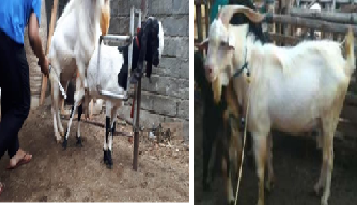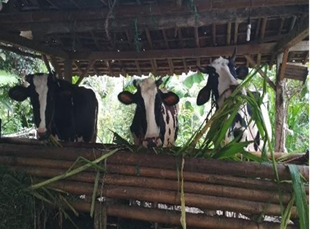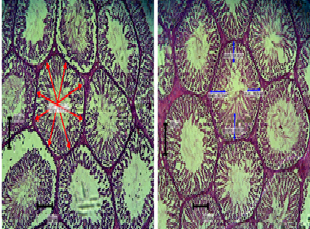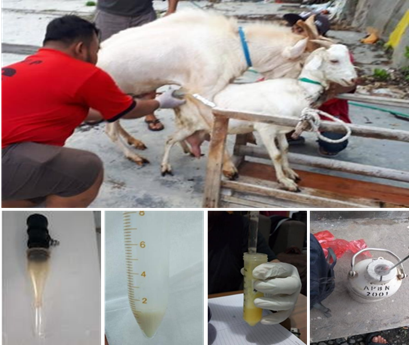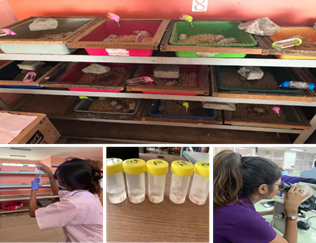Sex determination of Bangkok Zebra dove (Geopelia striata) based on wing and tail feather morphometrics at 3 and 6 months of age
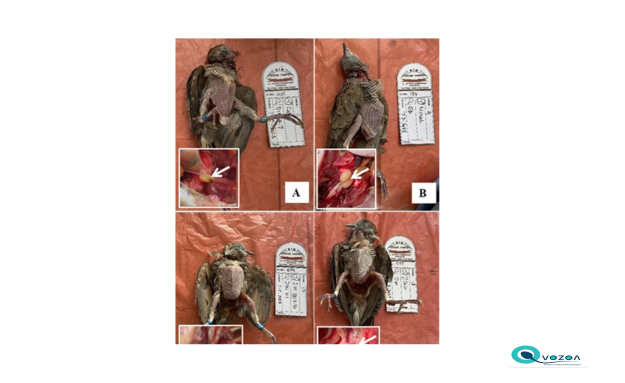
Downloads
This study aimed to determine the sex of Bangkok Zebra doves (Geopelia striata) based on external body morphometric measurements. A total of 32 doves were used, consisting of 16 females (8 bird each at 3 and 6 months of age) and 16 males (8 birds each at 3 and 6 months of age). Four morphometric parameters were measured: wing chord, antebrachium (forearm) length, longest primary feather, and longest tail feather. Wing and forearm lengths were measured using digital calipers with a precision of 0.01 mm, while the longest primary and tail feathers were measured using a ruler with 0.05 mm precision. The results showed that the average wing chord, longest primary feather, and longest tail feather lengths were significantly greater (p <0.05) in males compared to females. At six months of age, males also had a significantly longer forearm than females (p <0.05). However, no significant difference (p >0.05) was found in forearm length between sexes at three months of age. It could be concluded that wing and tail feather morphometrics can be used to distinguish between male and female Bangkok Zebra doves at both three and six months of age, except for forearm length at three months.
Amy M, Salvin P, Leboucher G. 2018. Chapter Six - The Functions of Female Calls in Birds. In: Naguib M, Barrett L, Healy SD, Podos J, Simmons LW, Zuk M (Eds). Advances in the Study of Behavior. Academic Press. 243-71.
Analla M, Fernández-Rodríguez P, Martínez-Medina N, Azorit C. 2022. Sexing eurasian eagle owls by external body and skeletal measurements. J Field Ornitol. 93: 3-6.
Audet JN, Ducatez S, Lefebvre L. 2014. Morphological and molecular sexing of the monochromatic Barbados bullfinch, Loxigilla barbadensis. Zoolog Sci. 31: 687-91.
Cabodevilla X, Moreno-Zarate L, Arroyo B. 2018. Differences in wing morphology between juvenile and adult European Zebra Doves Streptopelia turtur: Implications for migration and predator escape. Ibis 160: 458-63.
Çakmak E, Akın Pekşen Ç, Bilgin CC. 2017. Comparison of three different primer sets for sexing birds. J Vet Diagn Invest. 29: 59-63.
Cambrone C, Jean-Pierre A, Bezault E, Cézilly F. 2023. Identifying global research and conservation priorities for Columbidae: a quantitative approach using random forest models. Front Ecol Evol. 11: 1141072.
Catfolis B, Vanroy T, Verheyen K, Baeten L, Martel A, Pasmans F, Strubbe D, Lens L. 2023. Avian nutritional condition increases with forest structural complexity. Ecol Indic. 154: 110536.
Cerit H, Avanus K. 2007. Sex identification in avian species using DNA typing methods. Worlds Poult Sci J. 63: 91-9.
Dechaume-Moncharmont FX, Monceau K, Cézilly F. 2011. Sexing birds using discriminant function analysis: A critical appraisal. Auk 128: 78-86.
Dhamayanti Y, Nurizza K, Luqman EM, Hendarti GA, Setiawan B, Soeharsono S. 2023. Akurasi pendugaan jenis kelamin burung perkutut oleh breeder berdasarkan pengamatan morfologis dibandingkan dengan pemeriksaan organ produksi secara laparotomi.
Dias T, Lemoine NP, Yanco SW,Zimova M, Bay RA, Weeks BC. 2025. Long-termincreases in wing length occur independently of changes in climate and climate-driven shifts inbody size. Proc R Soc B 292: 20242556.
Estellés-Domingo I, López-López P. 2023. Non-invasive sex determination of nestlings and adult Bonelli's eagles using morphometrics. Animals (Basel) 13: 1201.
Fitzpatrick. 2001. Tail length in birds in relation to tail shape, general flight ecology and sexual selection. J Evol Biol. 12: 49-60,
Freeland LV, Emmerson MG, Vasas V, Gomes J, Versace E. 2025. Assessing preferences for adult versus juvenile features in young animals: Newly hatched chicks spontaneously approach red and large stimuli. Learn Behav. 53: 145-56.
Fuchs DV, Berríos VS, Montalti D. 2017. Morphometric differences between sexes in the white-faced Ibis (Plegadis chihi). Wilson J Ornithol. 129: 317-22.
Fülöp A, Németh Z, Kocsis B, Deák-Molnár B, Bozsoky T, Kőmüves G, Barta Z. 2022. Fighting ability, personality and melanin signalling in free-living Eurasian tree sparrows (Passer montanus). Peer J. 10: e13660.
Heers AM, Rankin JW, Hutchinson JR. 2018. Building a Bird: Musculoskeletal modeling and simulation of wing-assisted incline running during avian ontogeny. Front Bioeng Biotechnol. 6: 140.
Henry L, Biquand V, Craig AJ, Hausberger M. 2015. Sexing adult pale-winged starlings using morphometric and discriminant function analysis. PLoS One 10: e0135628.
Hološková A, Kadlec T, Reif J. 2023. Vegetation Structure and invertebrate food availability for birds in intensively used arable fields: Evaluation of three widespread crops. Diversity 15: 524.
Leys RAC, Grieves LA. 2023. Sex determination of Eastern White-crowned sparrows (Zonotrichia leucophrys leucophrys) using wing chord length. J Field Ornithol. 94:2.
Liukkonen M, Muriel J, Martínez-Padilla J, Nord A, Pakanen V-M, Rosivall B, Tilgar V, van Oers K, Grond K, Ruuskanen S. 2024. Seasonal and environmental factors contribute to the variation in the gut microbiome: A large-scale study of a small bird. J Anim Ecol. 93: 1475-92.
Ma S, Li P, Liu H, Xi Y, Xu Q, Qi J, Wang J, Li L, Wang J, Hu J, He H, Han C, Bai L. 2023. Genome-wide association analysis of the primary feather growth traits of duck: identification of potential loci for growth regulation. Poult Sci. 102: 102243.
Maness TJ, Anderson DJ. 2013. Predictors of juvenile survival in birds. Ornithological Monographs 67.
Meissner W, Kosmicki A, Niemczyk A, Fischer I. 2017. Development of sexual dimorphism and sexing of Baltic Herring gull (Larus arentatus argentatus) in succesive age classes. Waterbirds. 40: 24-32.
Møller AP, Garamszegi LZ, Gil D, Hurtrez-Boussès S, Eens M. 2005. Correlated evolution of male and female testosterone profiles in birds and its consequences. Behav Ecol Sociobiol. 58: 534-44.
Morinha F, Cabral JA, Bastos E. 2012. Molecular sexing of birds: A comparative review of polymerase chain reaction (PCR)-based methods. In: Theriogenology 78: 703-14.
Mueller HC, Berger DD, Mueller, NS Robichaud W, Kaspar JL. 2002. Age and sex differences in wing loading and other aerodynamic characteristics of merlins. Wilson Bull. 114: 272-5.
Nadal J, Ponz C, Margalida A. 2018. The effects of scaling on age, sex and size relationships in Red-legged partridges. Sci Rep. 8: 2174.
Nadal J, Ponz C, Margalida A. 2018. Feathers for escape: The transition from juvenile to adult in red-legged partridges (Alectoris rufa). Biol J Linn Soc Lond. 123: 72-8.
Names GR, Grindstaff JL, Westneat DF, Heidinger BJ. 2024. Climate change and its effects on body size and shape: the role of endocrine mechanisms. Phil Trans R Soc. 379: 20220509.
Pikus AE, Guindre-Parker S, Rubenstein DR. 2018. Testosterone, social status and parental care in a cooperatively breeding bird. Horm Behav. 97: 85-93.
Piro A, Fuchs DV, Montalti D. 2018. Morphometric differences between sexes of two subspecies of black-crowned night-heron (Nycticorax nycticorax) using discriminant function analysis. Waterbirds 41: 87-92.
Pittman M, Gatesy SM, Upchurch P, Goswami A, Hutchinson JR. 2013. Shake a tail feather: the evolution of the theropod tail into a stiff aerodynamic surface. PLoS One 8: e63115.
Ruaux G, Lumineau S, De Margerie E. 2020. The development of flight behaviours in birds. Proc R Soc B. 287: 1-4.
Soma KK. 2006. Testosterone and aggression: Berthold, birds and beyond. J Neuroendocrinol. 18: 543-51.
Tang L(S), Schwarzkopf L. 2013. Foraging behaviour of the Peaceful Dove (Geopelia striata) in relation to predation risk: group size and predator cues in a natural environment. Emu - Austral Ornithol. 113: 1-7. https://doi.org/10.1071/MU12023.
Templeton CN, Burt JM, Campbell SE, Lent K, Brenowitz EA, Beecher MD. 2012. Immediate and long-term effects of testosterone on song plasticity and learning in juvenile song sparrows. Behav Processes. 90: 254-60.
Terrill RS, Shultz AJ. 2023. Feather function and the evolution of birds. Biol Rev Camb Philos Soc. 98: 540-66.
Varga SZ, Juhász L. 2020. Morphometric age and sex identification of Eurasian collared doves (Streptopelia Decaocto friv.): A pilot-test. Rev Agric Rural Dev. 8: 113-9.
Wee YC, Wang LK. 2008. Breeding behaviour of the zebra dove, Geopelia Striata (Linnaeus, 1766). Nat Singap. 1: 75-80.
Yan Z, Isobe N, Kawakami SI. 2020. Effects of testicular and non-testicular testosterone on territorial and isolation-induced aggressive behavior of male layer chicks. J Poult Sci. 57: 236-40.
Copyright (c) 2025 Kamilah Nurizza, Yeni Dhamayanti, Epy Muhammad Luqman, Gracia Angelina Hendarti, Soeharsono Soeharsono, Boedi Setiawan

This work is licensed under a Creative Commons Attribution-ShareAlike 4.0 International License.
Ovozoa by Unair is licensed under a Creative Commons Attribution-ShareAlike 4.0 International License.
1. The journal allows the author to hold the copyright of the article without restrictions.
2. The journal allows the author(s) to retain publishing rights without restrictions
3. The legal formal aspect of journal publication accessibility refers to Creative Commons Attribution Share-Alike (CC BY-SA).
4. The Creative Commons Attribution Share-Alike (CC BY-SA) license allows re-distribution and re-use of a licensed work on the conditions that the creator is appropriately credited and that any derivative work is made available under "the same, similar or a compatible license”. Other than the conditions mentioned above, the editorial board is not responsible for copyright violation.





























